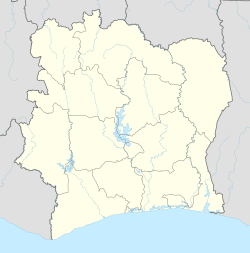
Back باسام الكبرى Arabic جراند بسام ARZ Grand-Bassam AST Grand-Bassam AVK Qrand-Bassam Azerbaijani Grand-Bassam Catalan Grand-Bassam CEB Grand Bassam Czech Grand-Bassam German Grand-Bassam Spanish
This article has multiple issues. Please help improve it or discuss these issues on the talk page. (Learn how and when to remove these messages)
|
Grand-Bassam | |
|---|---|
Town, sub-prefecture, and commune | |
 Colonial house in Grand-Bassam | |
| Coordinates: 5°12′N 3°44′W / 5.200°N 3.733°W[1] | |
| Country | |
| District | Comoé |
| Region | Sud-Comoé |
| Department | Grand-Bassam |
| Area | |
• Total | 127 km2 (49 sq mi) |
| Population (2021 census)[3] | |
• Total | 124,567 |
| • Density | 980/km2 (2,500/sq mi) |
| • Town | 74,671[2] |
| (2014 census) | |
| Time zone | UTC+0 (GMT) |
| Official name | Historic Town of Grand-Bassam |
| Criteria | Cultural: (iii), (iv) |
| Reference | 1322rev |
| Inscription | 2012 (36th Session) |
| Area | 109.89 ha (0.4243 sq mi) |
| Buffer zone | 552.39 ha (2.1328 sq mi) |
| Official name | Grand Bassam |
| Designated | 18 October 2005 |
| Reference no. | 1583[4] |
Grand-Bassam (French pronunciation: [ɡʁɑ̃ basam]) is a town in southeastern Ivory Coast, lying east of Abidjan. It is a sub-prefecture of and the seat of Grand-Bassam Department; it is also a commune. During the late 19th century, Grand-Bassam was briefly the French colonial capital of Ivory Coast. Because of its outstanding examples of colonial architecture and town-planning, and the juxtaposition of the colonial town with a traditional Nzema village, the historic center of Grand-Bassam was designated a UNESCO World Heritage Site in 2012.[5]
In 2021, the population of the sub-prefecture of Grand-Bassam was 124,567.[3]
- ^ "Ivory Coast Cities Longitude & Latitude". Sphereinfo.com. Archived from the original on 13 September 2012. Retrieved 19 November 2010.
- ^ Citypopulation.de Population of cities & localities in Ivory Coast
- ^ a b Citypopulation.de Population of the regions and sub-prefectures of Ivory Coast
- ^ "Grand Bassam". Ramsar Sites Information Service. Retrieved 25 April 2018.
- ^ "Historic Town of Grand-Bassam". UNESCO World Heritage Centre. United Nations Educational, Scientific, and Cultural Organization. Retrieved 27 August 2017.
